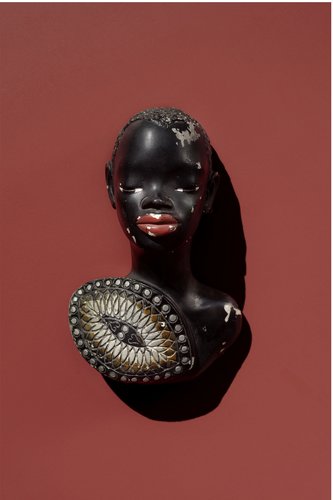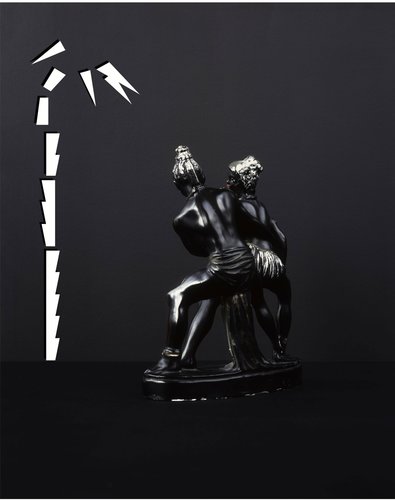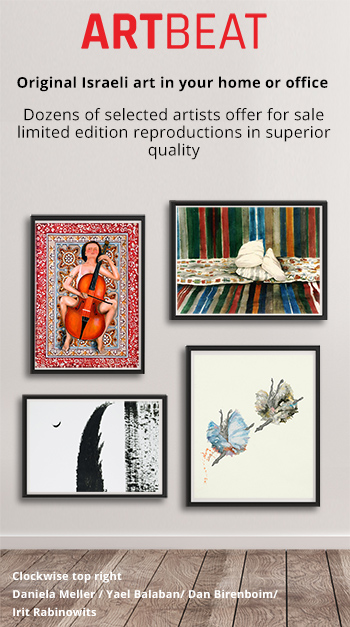Art Shows > Black Market
Black Market / Braverman Gallery06/02/2020 to - 30/04/2020 In the Black Market exhibition, David Adika presents a series of photographs that were created during the past two years as part of his ongoing pursuit of decorative objects with an imprint of daily life and home environments; Ornaments through which cultural tensions are reflected. Adika focuses on figurines mainly painted in black, made of plaster, Bakelite or brass . The figurines were molded in mass production, created in the country in the 1960s and 1970s by local creators such as 'Oriental', 'agricultural' and more. The makers worked in Tel Aviv (for example, "Mizrachi" in the Hope neighborhood), and followed the "colonialist" trends, seeking the alien, the black and the exotic. Today, the same figures can be found in flea markets, or auctions; Some of them carry local tax and 'authentic' stamp in English . Adika presents the black figures on the scale between tribal, savage and sexual, and having therapeutic or magical power. They are stationed in the studio, and are photographed under the sun and with her help. Adika's photographic activities, alongside the modes of posing and recreating them as contemporary objects , emphasize the problematic set of contexts in which they were created and their purpose . Adika traces the nature of local cultural symbols at different times through the dissonance that exists between object production and the tragic-iconic baggage they carry. He is interested in the evolutionary development of concepts such as 'taste', 'definition', 'society' and their changing relevance, through questions of cultural appropriation and visual expression. As an artist who collects information from the weaves of art history, in the context of space and time, the Black Market series is further evidence of the complexity of the production of cultural, identity and geopolitical boundaries . The works in the 'Black Market' exhibition constitute a continuation of a large-scale series called 'Africana', created between 2018-2016 and including photographs, network prints and objects. Like 'Afrikana', Adika also focuses on objects as identity conductors, and in still life as a continuation or as a substitute of the body as a political entity . The 'Afrana' series featured a visual-reflective-thematic discussion of pottery and urns created in the country in the 1950s, 1960s and 1970s by local companies such as 'Naaman', 'Lapid', 'Pal Ceramic', 'The Creator', and more. Because of their creators' desire to create authentic Israeli material language, and because of their identification with ideology and place, tools such as these are known in Israel under the title 'Israeliana '. Adika's photographs show how the new, modern-Western Israeli identity has adopted, not necessarily consciously, African aesthetics - an exotic authentic roots under the guise of modernism . Today, they can be found in flea markets - usually damaged and slightly broken - where Adika acquires them, building a collection of earthy Israelis and aesthetics that are associated with the spirit of modernism of the country's early decades. When he photographs them against a background of complementary colors of wood, he extracts from the pottery the layers of African influence, which have so far not been illuminated and have not been recorded in consciousness: the shapes, the colors, the design . ' As part of encounters between artists and contemporary artists and the public to Museum of Modern Art in New York (MoMA), said the artist Kara Walker (Kara Walker) in 1999, the sources of inspiration for creativity. Searching for the meaning of the word Blackness and from trying to understand its essence, she held a notebook into which she added words, ideas and images and basically anything that allowed her to understand what Blackness was to her. At the same time, Walker collected small objects from Black Americana from flea markets, sometimes reproductions of works or products of mass production. Through them, she said, she tried to understand "who I am beyond this skin that I am in" A similar question that Walker posed early in her career as an artist and which she continues to engage in today, was formulated by Adika in the 'Mahogany' exhibition, exhibited at the Herzliya Museum of Contemporary Art (curator: Dalia Levin) in 2003. Adika photographed wooden figurines brought by his father to one of his travels to Africa As decorative objects in his parents' home. The statuettes, small wooden figurines for tourists, were printed in large format and received monumental representation . The title 'mahogany' added to the aura of the fine wood (unrelated to it, these are made of light wood in black, in shoe polish) and also hinted at a pun: what a ghoulish 'question Adika referred - both with regard to sculptures and to himself - suggested A link, the first of its kind in Israeli art, between the African black and the relative blackness of the Mizrahi people in Israel, which incidentally diverted the post-colonial discourse into the local sectarian context . ' Curator Hadas Maor defined Adika's early works as generators of dissolution of fundamental assumptions between East and West and incidentally refer to Frederick Jameson's "unconscious political" concept, inherent in both the fractured reality in which the works were created and the viewer's consciousness . Many of the works deal with the question of surface tension and essence, between visibility and meaning. They stretch, expand, and transform the concept of identity, emphasizing the tension between the inherited dimension of origin (expressed in skin color, for example) and the acquired dimension, which is dependent on culture and language (expressed in moral and aesthetic values, for example), two dimensions that involve Immanent and inseparable in concept. In the meantime, elements of alienity, refugees, blacksmiths, displaced persons, cultural renditions, forgeries and the like lurk in imagery, whose objects are like subjects of cultural genetic cargo, but a cargo that has long been disconnected from the context of time and place, which provides Ever been natural . ' In the Black Market series, Adika continues to look for other possibilities to tell the 'narrative' of the place and the assimilation of 'Africa' into Israeli society and culture. He places the concept of 'africana' as an essential part of the 'elements of' the Israeli. In turning his gaze to Africa, through 'cultural products and decorative objects' from the past, Adika offers another angle to examine the longings and anxieties that shape society in Israel - from its beginnings to the present, and in light of all the infrastructural-Israeli initiatives that are being realized in the black continent . ' Since the 1960s, Israel has been involved in Africa - economically, culturally and politically. In the decades that have passed, "Africa" has settled in Israeli culture as a place, idea and geopolitical concept . ' Through the works and the historical and contemporary context, Adika seeks to respond to the new Israeli space, exploring what happens to 'Africa' as she arrives in Israel and what discourse emerges around African immigrants (objects and people) upon arriving in Tel Aviv . Today's Africa, like Africa's time, functions as a consciousness and geographical space that can be imposed, or realized, in Zionist, territorial, commercial, capitalist and racial fantasies. State action and its mechanisms in Africa have created a sense of seemingly shared history and of colonization. These, however, actually helped build the national identity in Israel and establish a white and modern identity . The gallery's gallery includes a wall painting by invitation from the artist Roni Karni. The painted and painted wall asks 'reporters' from Miriam Bartov's book to the children's book 'Little Alikma', and serves as a decorative platform for some of the photographs, while seeking to re-place them within the gallery's order and the art world's procedure . location - Braverman Gallery אילת 33, תל אביב Time - 06/02/2020 to - 30/04/2020 Exhibition opening - 06/02/2020 Link - https://bravermangallery.com/exhibitions/black-market/ |
The content appearing on this page and the details of this exhibition are shown on the behalf of the advertisers and on their responsibility.
All rights reserved to - artbeat.co.il © Israel Art
|1|



